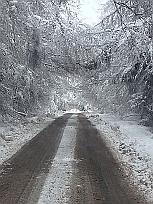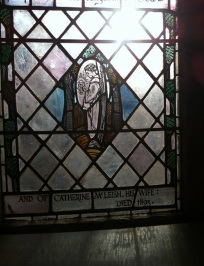 Snow Perthshire 2012 Snow Perthshire 2012 On the same night the first UK snow fell of 2013 Who Do You Think You Are Episode 8 coincidently showed comedienne Sarah Millican grappling with snow shoes ‘reliving’ the struggles her ancestor John Malcolm faced and it served as a double reminder that it will soon be time to batten down the hatches here in Scotland. Every year WDYTYA always heralds this changing of the seasons and is a reminder to get on planning my own research for next year however the months when the show is scheduled also offer a last chance to enjoy being out and about before the winter kicks in. The evenings are not a time for sitting watching television when there are plenty of other things to be done like clearing the garden or exploring cemeteries and other ancestral haunts! It is time to look forward to drawing the curtains early in forthcoming winter months and discovering more family history so spring can be greeted with a jam packed new ancestral tour schedule. The format of Who Do You Think You Are 2013 has very clearly highlighted the steps along the ancestral journey that can be followed. If you haven’t tried it, the experience is not reserved for the celebrities amongst us although the wearing of nineteenth century diving gear is not obligatory – hats off to Sarah Millican who literally and emotionally took the weight of her ancestors on her shoulders. As highlighted in the show 1 Have a cuppa with friends and family find out more. Start with what you know. Ask questions. Write down what you discover and those ancestors you would like to find out more about. 2 Draw Up Family Tree. The show skims over this bit somewhat. It probably wouldn’t make that good television although as a researcher this is one of the most thrilling parts of genealogy and family history. Start with your chosen person; you, your mother/father - (your spouse, your children make good starting points too) and concentrate on the Genealogy i.e. who begot who. Use the basic blocks of genealogical research - Births Deaths and Marriages and Census Records which are available back almost 200 years in the UK and research further back with the evidence you find from the previous generation. Have a clear aim: research a particular line or number of generations in mind at the outset. Stop there and spend the dark nights of the coming winter months filling in some further details about your Family History. 3 Pick out the extraordinary or what fascinates you. With ancestors doubling every generation there is plenty to discover. Find out more about a place or person, a trade, did they serve in WW1. Search for them in historical online newspapers. There are plenty more of local and historical sources on line for finding out background information and archives, museums and libraries make great places to visit at any time of the year. The variation and amount of sources available has been very well highlighted on the show this year. So whilst the show skips over initial genealogy research the proportion of air time spent on family history later is a balance well struck. There is so much more that you can discover over and above the names and vital information for your ancestors, like many of the celebrities you may feel you actually get to know them personally. 4 Explore and Experience. Get out there on an genealogy tour next spring or if you have Scottish ancestors take a vacation in Homecoming 2014. 5 Present and share your discoveries with your audience – your friends and family, online or in person – tell Old Scottish about it here. Penny
0 Comments
As a genealogist and family historian what appeals to me about this project is it takes place as a defining characteristic but then elevates the status of people by choosing to record each individual inhabitant's details in history to discover the story of the people and the place over time. City, town, village or hamlet what are they without the community that builds and inhabits each over the centuries? In terms of day to day research we often find ourselves exploring many new places looking for people,we are virtual tourists and time travellers. Knowing the place where you last saw the ancestor you seek is crucial in being able to find out what records they may have left behind - and where those records are held today. I am looking forward to my next visit to Newbiggin and hope that in some small way Old Scottish can contribute a little information in a local or dear place, such as Kinclaven that provides a signpost for another genealogist or family historian on their ancestral journey. The Newbiggin by the Sea project is looking for volunteers and a meeting is to be held on 21st September. For more details see the New Post Leader article Penny It’s not every day you have to wait half an hour in a queue to get into a library, but then the Chepman and Myllar Prints are not just any books. They are, to use a term used sparingly by the discerning bibliophile, important. Not to my mind especially because of their content – a series of short chapbooks of vernacular literature in Scots and English, including perhaps my favourite Scots poem, The Flyting of Dumbar and Kennedie – but because of what they represent: the arrival of printing in Scotland. These unique survivors – now bound in a 1951 vellum binding – are a link back over 500 years to what has been regarded as a golden age in Scottish history. They were put on public display yesterday for 2 hours to mark the 500th anniversary of the Battle of Flodden.
Walter Chepman and Androw Myllar founded their press in 1508 under a charter issued by James IV in 1507. James IV is seen as a highly cultured figure, a renaissance prince who, in addition to introducing printing to Scotland, was a patron of the arts generally, and a sponsor of the Scots makars in particular. His reign brought much-needed stability to a Scotland often riven by internecine fighting and the ever-restless Highlands. He finally brought the Lord of the Isles under control in 1493, and built up the Scottish navy of 38 ships, including the Great Michael, at 240 feet and 1000 tonnes the largest ship in Europe at the time of its launch in 1511. James IV’s reign finally came to an end on the battlefield at Flodden, exactly 500 years ago on 9 September 1513. The Scots defeat at Flodden was comprehensive, with thousands dead, with barely a noble family unaffected. The battle did however give rise to two cultural highlights: Walter Scott’s epic poem Marmion, and the haunting lament Flowers of the Forest. Fergus  Welcome to Old Scottish Genealogy and Family History and our new blog! Our website is 'launching' and we envisage this blog as a place where you can find out about all our latest genealogy and family history news and resources in (almost) real time. We shall be making regular updates to the site in the new few months as we bring our existing and new services on line - there are already genealogy packages to jump start your Scottish family tree research, our in-house engraved genealogy plaques to show off your research and resources such as our first One-Place study - Kinclaven, Perthshire. Penny  We started uploading the introductory information for our new one-place study for Kinclaven today. This category in our blog will hopefully keep everyone updated on the genealogy, family history and local history resources that we are adding. Subscribe to our blog feed to remain updated on the Kinclaven project. You will find all the introductory information and links to the resources here on our website.We have no ancestral connection with the parish but it is a place, dear to our hearts: where we have lived,worked and been involved with the community and church congregation over the last few decades. Encouraged by the newly launched Society for One Place Studies we decided to bring what we have discovered about Kinclaven to you and share our resources. We hope that by spending time discovering and publishing all the local valuable resources we can find for one parish in Scotland Old Scottish will contribute information helpful to many researchers across the globe. The above image is of a panel from a stained glass memorial window on the East Wall of Kinclaven Parish Church. The window is dedicated toHope ROBERTSON, farmer at Innernyte, Kincalven and Catherine MACLEISH his wife, it depicts the farming year and 'the sower'. The first seeds of the Kinclaven One-Place study are sown and we hope that you will enjoy watching them grow and benefit from the 'crop' of resources to come. |
Old ScottishGenealogy and Family History - A mix of our news, curious and intriguing discoveries. Research hints and resources to grow your family tree in Scotland from our team. Archives
November 2022
Categories
All
|
- Home
-
Records
- Board of Supervision
- Fathers Found
- Asylum Patients
- Sheriff Court Paternity Decrees
- Sheriff Court Extract Decrees
- School Leaving Certificates
-
Crown Office Cases AD8
>
- AD8 index 1890 01
- AD8 index 1890 02
- AD8 index 1890 03
- AD8 index 1890 04
- AD8 index 1890 05
- AD8 index 1890 06
- AD8 index 1890 07
- AD8 index 1890 08
- AD8 index 1890 09
- AD8 index 1890 10
- AD8 index 1890 11
- AD8 index 1900 1
- AD8 index 1900 2
- AD8 index 1900 3
- AD8 index 1900 4
- AD8 index 1900 5
- AD8 index 1900 6
- AD8 index 1905 1
- AD8 index 1905 2
- AD8 index 1905 3
- AD8 index 1905 4
- AD8 index 1905 5
- AD8 index 1905 6
- AD8 index 1915 1
- AD8 index 1915 2
- Crown Counsel Procedure Books
- Sheriff Court Criminal Records
- Convict criminal records
-
Workmens Compensation Act Records
>
- Workmens Compensation Act Dundee 1
- Workmens Compensation Act Dundee 2
- Workmens Compensation Act Dundee 3
- Workmens Compensation Act Dundee 4
- Workmens Compensation Act Dundee 5
- Workmens Compensation Act Dundee 6
- Workmens Compensation Act Forfar 1
- Workmens Compensation Act Banff 1
- Workmens Compensation Act Perth 1
- Registers of Deeds
- General Register of the Poor
- Registers of Sudden Deaths
- Anatomy Registers
-
Resources
- Blog
- Contact
- Shop
|
Data Protection Register Registration Number: ZA018996 |


 RSS Feed
RSS Feed
